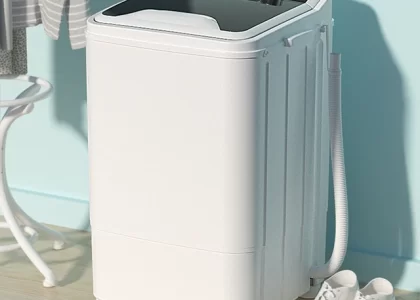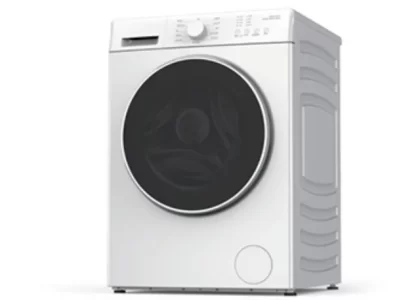 Introduction:
Introduction:
Washing clothes in a washing machine is a convenient and efficient way to keep your garments clean and fresh. However, for those new to using a washing machine or looking for a refresher, it’s important to understand the proper steps for effective clothes washing. In this comprehensive guide, we will walk you through the step-by-step process of washing clothes in a washing machine. By following these simple instructions, you can ensure clean and well-maintained garments for everyday wear.
 Here are some common types of washing machines:
Here are some common types of washing machines:
There are several types of washing machines available in the market today, each offering unique features and functionalities. Here are some common types of washing machines:
Top-Load Washing Machine:
Top-load machines have a vertical drum that is accessed from the top of the unit. They are popular for their ease of use, as you can simply lift the lid and add or remove clothes during the wash cycle. Top-load washers often have shorter wash cycles compared to front-load washers.
Front-Load Washing Machine:
Front-load machines have a horizontal drum that is accessed from the front of the unit. These machines typically offer higher capacities, greater water and energy efficiency, and gentler washing cycles compared to top-load models. Front-load washers also tend to have more advanced features and settings.
High-Efficiency (HE) Washing Machine:
HE washing machines are designed to use less water and energy compared to traditional models. They typically have larger capacities, faster spin speeds, and specialized wash cycles. HE machines are known for their superior cleaning performance and fabric care.
Compact Washing Machine:
Compact washers are smaller in size and are designed for apartments, small spaces, or for those who have limited laundry needs. These machines can be either top-load or front-load and offer convenience in tight spaces without compromising on functionality.
Fully Automatic Washing Machine:
Fully automatic machines handle the entire washing process, including filling water, detergent dispensing, washing, rinsing, and draining. Once you set the desired program, the machine operates automatically, saving time and effort.
Semi-Automatic Washing Machine:
Semi-automatic machines require some manual intervention during the washing process. You need to manually transfer the clothes between the wash and spin tubs for washing and draining. These machines are often more affordable and allow greater control over the washing process.
Smart Washing Machine:
Smart washing machines are equipped with Wi-Fi or Bluetooth features, allowing you to control and monitor your machine remotely through mobile applications or voice assistants. These machines offer convenience, advanced settings, and the ability to customize wash cycles.
These are some of the common types of washing machines available. When choosing a washing machine, consider factors such as capacity, energy efficiency, available space, budget, and the specific features that align with your laundry needs.
 Sorting and Preparing Clothes
Sorting and Preparing Clothes
Sort by Color:
Separate clothes into different piles based on color and fabric type.
Washing darker colors separately from lighter colors prevents color bleeding and maintains the vibrancy of your clothing.
Check Labels:
Read clothing labels to determine proper care instructions, including water temperature, recommended cycle, and any specific precautions.
Sort clothes based on the recommended care instructions to prevent damage or shrinking.
Empty Pockets and Close Zippers:
Empty all pockets of clothes to prevent items from getting tangled or damaged during the wash.
Ensure that all zippers and fasteners are closed to prevent snagging or catching on other garments.
Loading the Washing Machine
Balance the Load:
Distribute clothes evenly in the washing machine for a balanced load.
A balanced load prevents the machine from shaking excessively and allows for proper water and detergent distribution.
Avoid Overloading:
Do not overload the washing machine as it can affect the cleaning efficiency and may damage the machine or clothes.
Follow the manufacturer’s instructions for the maximum load capacity of your specific washing machine model.
 Choosing the Proper Settings
Choosing the Proper Settings
Select Water Temperature:
Choose the water temperature based on the care instructions of your clothes.
Use hot water for whites and heavily soiled items, warm water for colors, and cold water for delicate fabrics or clothes that may shrink.
Choose the Washing Cycle:
Select the appropriate washing cycle for your clothes, considering factors such as fabric type, level of dirtiness, and delicacy.
Common washing cycles include normal, delicate, heavy-duty, and quick wash.
Add Detergent:
Follow the manufacturer’s instructions to determine the appropriate amount of detergent for your load size.
Use liquid or powdered detergent based on personal preference and the compatibility of your washing machine.
Running the Washing Machine
Start the Wash Cycle:
Close the washing machine lid or door, and start the wash cycle according to the selected settings.
Allow the washing machine to run through the complete cycle without interruption.
Add Fabric Softener, if Desired:
If using fabric softener, add it during the rinse cycle according to the manufacturer’s instructions.
Fabric softener can add freshness and make clothes feel softer and more comfortable.
Proper Handling After Washing
Remove Clothes Promptly:
Remove clothes promptly after the wash cycle has finished to prevent odor and wrinkles.
Leaving clothes for an extended period can result in a musty smell and require rewashing.
Shake Out and Smooth Clothes:
Shake out each garment gently to remove any wrinkles or entangled items.
Smooth out clothes with your hands before hanging or folding to help maintain their shape.
Air-Dry or Tumble Dry:
Follow the care instructions on the garment labels to determine whether to air-dry or tumble dry the clothes.
Hang garments on a clothesline or use a drying rack for air drying, or place them in the dryer according to fabric recommendations.
 Conclusion:
Conclusion:
Washing clothes in a washing machine is a simple and efficient way to maintain clean and fresh garments. By following the step-by-step instructions provided in this comprehensive guide, you can effectively wash clothes in a washing machine and prolong the lifespan of your clothing. Remember to sort and prepare clothes, load the washing machine properly, choose the correct settings, and handle clothes with care after washing. With proper washing techniques, you can achieve clean and well-maintained clothes for everyday wear.





